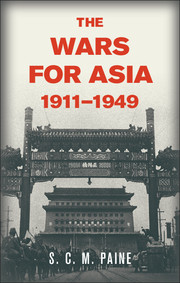3 - China 1926–1936
Chaos and the Quest for the Mandate of Heaven
Published online by Cambridge University Press: 05 September 2012
Summary
苦撐待變
Endure bitterness, await change.
(Bide one’s time.)In Chinese history, devastating chaos characterized periods between dynasties. Prosperity resulted from unity and stable rule, while dynastic change heralded warfare on an empirewide scale, ruining provinces for decades. The Chinese have portrayed their history in terms of a dynastic cycle, consisting of the rise, the maturation, and the decline of a ruling house, followed by a chaotic interregnum before the rise of a successor dynasty. This analytical framework followed Buddhist beliefs about the birth, maturation, decay, and death of all living things, and the rebirth of life each spring after the dead of winter. According to this framework, dynasties on the rise or at their peak held the mandate of heaven, the cosmic legitimacy to rule. Those that lost their mandate could expect imminent overthrow. After the fall of the Qing dynasty in 1911, China faced a long and bloody interregnum that lasted until the Communists finally reunified much of the Qing empire in 1949.
Just as Japanese leaders faced terrible dilemmas in 1930s – to work within the gridlocked international order or to take decisive action – Chinese leaders faced lethal choices. Although there was a growing consensus that Confucianism could no longer serve as the unalterable philosophical bedrock of China, there was great discord over its replacement. Everyone wanted a New China, but what sort of institutions should it have? China’s ethnic minorities saw an opportunity to slip the Han-Chinese imperial leash. Tibet broke away after 1912 and remained independent until the People’s Liberation Army rolled in two generation later in 1951. Outer Mongolia broke away with Russian help to become the People’s Republic of Mongolia in 1924. The Muslims of Xinjiang also attempted to leave. Certain regional warlords simply wanted home rule, such as the opium-financed Yan Xishan, long the ruler of Shanxi, or the opium-financed Long Yun of the Lolo minority, long the ruler of Yunnan. Others had national ambitions such as Li Zongren of the Guangxi group in the South, the Zhang clan of Manchuria, and Feng Yuxiang, the Christian warlord of North China. The latter type desired to reunify China under their personal hegemony and so constituted alternatives to Chiang Kai-shek’s government.
- Type
- Chapter
- Information
- The Wars for Asia, 1911–1949 , pp. 48 - 76Publisher: Cambridge University PressPrint publication year: 2012



